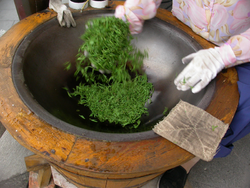- China famous tea
-
China's Famous Teas (中国名茶) or The Ten Great Chinese Teas (中国十大名茶) is a list of ten notable Chinese teas. Contrary to popular belief, there is no steadfast list. The list varies considerably depending on the area where it is compiled and the current trend of tea consumption.[1]
The list below, however, is considered the most top ten famous teas by the Chinese Ranking Association in 1959: Xi Hu Longjing, Dongting Bi Luo Chun, Anxi Tie Guan Yin, Huang Shan Mao Feng, Wuyi Yan Cha, Qimen Hong Cha, Liuan Gua Pian, Yunnan Pu'er and Bai Hao Yin Zhen.[2]
Different sources cite different teas, but the following table compiles twenty different such lists and ranks the teas upon recurrence.
Tea Name Pronunciation Occurrences English Origin Type 西湖龙井 Xi Hu Longjing 20 Dragon Well Hangzhou, Zhejiang Green tea 洞庭碧螺春 Dongting Bi Luo Chun 20 Green Spiral Suzhou, Jiangsu 安溪铁观音 Anxi Tie Guan Yin 20 Iron Goddess Anxi, Fujian Oolong tea 黄山毛峰 Huang Shan Mao Feng 17 Yellow Mountain Tip Huangshan, Anhui Green tea 武夷岩茶 Wuyi Yan Cha 16 Red Robe Wuyi, Fujian Oolong tea 君山银针 Junshan Yin Zhen 14 Silver Needle Yueyang, Hunan Yellow tea 祁门红茶 Qimen Hong Cha 12 Keemun Black Qimen, Anhui Black tea 六安瓜片 Liuan Gua Pian 11 Liuan Leaf Jinzhai, Anhui Green tea 云南普洱 Yunnan Pu'er 10 Puer tea Simao, Yunnan Post-fermented tea 白毫银针 Bai Hao Yin Zhen 10 White Silver Needle Fuding, Fujian White tea Contents
Features
Chinese tea has a long history and wild varieties. China famous teas are separated into two groups: Traditional famous teas and Historical famous teas. The Ten Great Chinese Teas are the treasures among the vast varieties of teas. At the same time, China famous tea owns a high reputation in the international arena.
There are no particular concepts to judge whether the tea is great or not. However, there are some basic characteristics a 'great tea' must be followed: each of them should have its own unique style, mainly in the color, fragrance, taste and the shape of the tea.
Description
Here are some descriptions about two most famous teas which are well-known among individuals.
West Lake (Xihu) Longjing, the China's most famous tea, is produced in the mountains around the West Lake in Hangzhou, Zhejiang Province. West Lake is famous not only due to its sense of beauty, but also the acclaimed Longjing tea around the world. West Lake (Xihu) Longjing has thousands of years of history. It is renowned starting from the time of the Tang dynasty. Longjing tea has sharpened and flat leaves. The color of the leaves is green with yellow. After brewing, the tea aroma can last for a long time; the color becomes almond green, clear and bright. When drinking with it, the fresh tastes will surely attract you. People praise Longjing tea as 'the gold bud' and 'the world unparalleled'. It becomes the China's national tea. [3]
It is one of the most famous green tea in China, produced in Tai Lake, Dongting mountain, Suzhou, Jiangsu province.
Bi Luochun leaves appear slender, curled, verdurous and tiny fluffies can be observed. When brewing the high quality Bi Luochun, we can first get water and then add the tea in, the leaves are still going to slowly sink. Dongting Bi Luochun is distinctive and world famous. It is not only well-selled in demestic market, but also exported to Japan, the United States, Germany, Singapore and more other countries as advanced gifts.
See also
- Si Da Ming Cong for a list of the 4 notable Wuyi Oolong teas.
- Chinese teas
References
- ^ "Famous Chinese Teas". Chinese-Tea-Culture. http://www.chinese-tea-culture.com/famous-chinese-teas.html. Accessed June 2011.
- ^ "China top ten famous teas". http://baike.baidu.com/view/5512.htm. Retrieved 11 November 2011.
- ^ "Longjing Green Tea". http://www.longjinggreentea.com. Retrieved 11 November 2011.
Tea Black tea Oolong tea - Bai Ji Guan
- Red Robe
- Darjeeling Oolong
- Dongding (Tung-ting)
- Dong Fang Mei Ren
- Huangjin Gui (Golden Osmanthus)
- Qilan tea
- Pouchong
- Rou Gui
- Shui Jin Gui
- Shui Hsien (Shui Xian)
- Tie Luohan
- Tieguanyin (Iron Goddess)
Green tea - Aracha
- Bancha
- Green Spiral
- Chun Mee
- Da Fang
- Genmaicha
- Liuan Leaf
- Gunpowder
- Gyokuro
- Hojicha
- Hou Kui
- Huang Shan Mao Feng
- Hyson
- Kabusecha
- Kamairicha
- Konacha
- Kukicha
- Longjing (Dragon Well)
- Matcha
- Mao Jian
- Mecha
- Meng Ding Gan Lu
- Sencha
- Shincha
- Tamaryokucha
White tea Yellow tea Post-fermented tea Blended and
flavoured teasTea culture Tea beverages Other - Camellia sinensis (tea plant)
- Tea bag
- Teapot
- Consumption
- Flowering tea
- Glass-holder
- Health effects
- Tea processing
- Samovar
- Tea brick
- Tea garden
- Tea house
- Tea tasting
- Teakettle
See also - Herbal tea
- Mate
- Rooibos
- China famous tea
Categories:- Chinese cuisine stubs
- Tea stubs
- China famous tea
Wikimedia Foundation. 2010.



